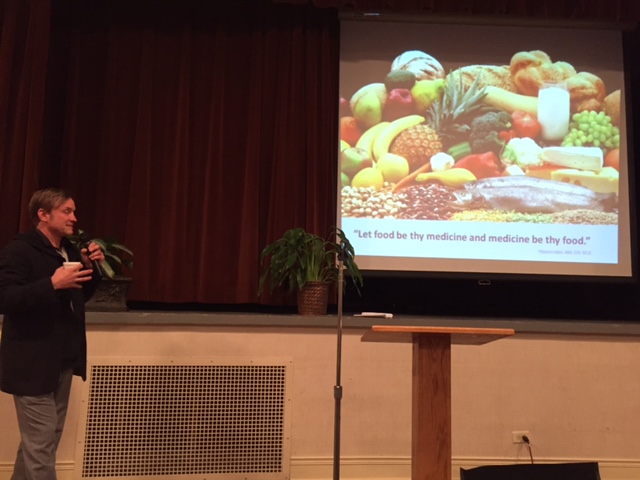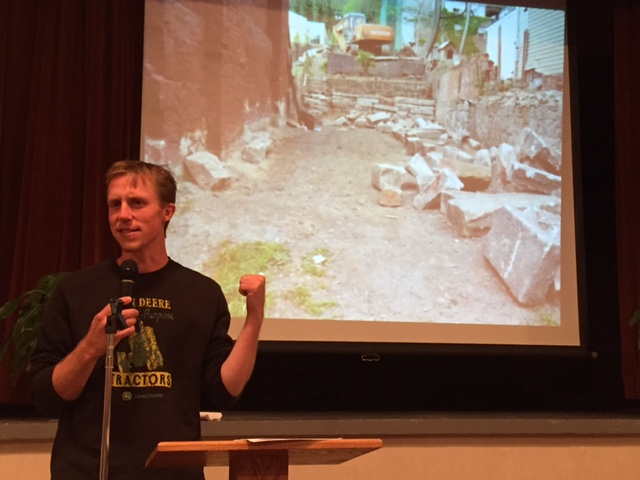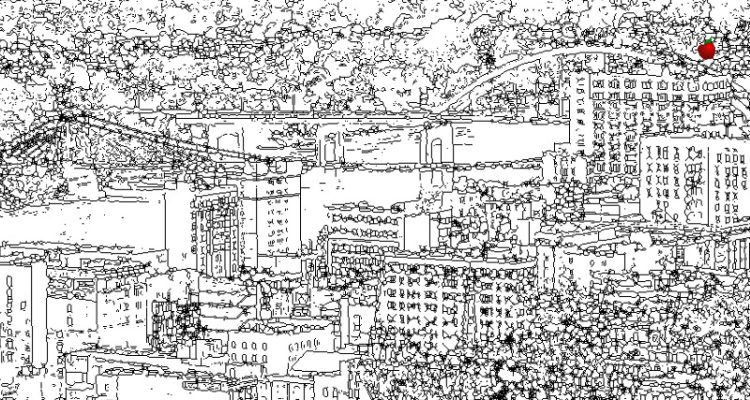This article is presented via a Weelunk partnership with Dateline:Wheeling.
For more great Lee Chottiner stories, poetry, and images that focus on Wheeling, go to DatelineWheeling.com.
Hun-ger /ˈhəNGɡər/ — the state of not having enough food to eat, especially when this causes illness or death
— Oxford Advanced Learners Dictionary
Ken Peralta read that definition aloud Sunday night, Oct. 18, at Temple Shalom. He liked it enough to include it in his PowerPoint presentation on hunger in the Ohio Valley, but to him, it just didn’t go far enough.
He flashed on the screen photos of emaciated children from around the world — the kind of images people think of when they think of hunger.
Then he showed a shot of a morbidly obese man. He also suffered from hunger – only in a different way.
How?
“This man’s body is not absorbing the nutrition that would help him lead a healthy, more productive life,” he said.
According to Peralta and Danny Swan, the founders of Grow Ohio Valley, hunger means more than not having enough food to eat, feeling a knowing pang in your stomach. It also means not having enough of the right food to eat – fresh vegetables, whole grains, foods low in sugar but high in anti-oxidants and phytochemicals – plant chemicals that can keep the body healthy and ward off disease.

Swan and Peralta were the first speakers in the 2015-16 Temple Shalom Social Action Lecture Series. Some 40 people from across the community gathered at the synagogue to hear the two men describe the local hunger problem, and what can be done about it.
They talked at length about “blue zones,” places around the world where people cultivate their own wholesome food and frequently live to be 100 or older.
While West Virginia has the third oldest population in the union – and Ohio County has the third oldest population in West Virginia – Wheeling and the rest of the state are not blue zones, they said, and for good reasons: West Virginia ranks at or near the top in state ranking for rates of diabetes, hypertension, heart attacks, high cholesterol and obesity.
Further, the state has too many places where access to healthy food is hard to get, especially for senior citizens.
In many ways, West Virginia, and Wheeling, are simply not healthy places to live.
There are “irrefutable connections,” Peralta said, “between what we eat and our bodies’ ability to repair themselves.”
Quoting from Hippocrates he said, “Let food be thy medicine, and medicine be thy food.”
Food deserts
Painting a picture of the hunger problem in the Ohio Valley, Peralta said the Wheeling area has too many “food deserts.”
Food deserts, according to the Centers for Disease Control and Prevention, “are areas that lack access to affordable fruits, vegetables, whole grains, low-fat milk, and other foods that make up the full range of a healthy diet.”
“As you can imagine, Wheeling has quite a few food deserts,” Peralta said. “We’re in a perfect storm for food deserts because we don’t have a lot of grocery stores, we don’t have a great public transportation system, and we have an aging population.”
Despite those deserts, Swan said there are solutions.
One course is to have more people grow their own food on whatever land is available. He started such an initiative seven years ago, called the East Wheeling Community Gardens, a series of garden plots on vacant lots where houses once stood, divided by leftover foundation stones. Those plots were made available to residents interested in gardening.
The result was an abundance of fresh produce and a community gathering spot that changed the quality of life in East Wheeling – for the better.

“This became the summer neighborhood hangout,” Swan said. “It’s where people came to spend their evenings.”
Even Mayor Andy McKenzie, believing the gardens were tamping down crime in the neighborhood, stopped by to congratulate them, Swan added.
The gardens led to the founding of Grow Ohio Valley in 2014. A not-for-profit organization, Grow OV promotes food justice in the Upper Ohio Valley by spurring economic and social transformation through urban farming.
Grow OV has built year round greenhouses in East Wheeling. It has planted vegetables on Department of Highways property. It started a “mobile farmers market” that visits neighborhoods around the area six days a week It has set up community gardens in senior high rises and at grade schools – all with the goal of getting young and old alike outside, onto the land, socializing with one another as they grow the right food for their bodies.
“The way you get a kid to eat a tomato is to get a kid to grow a tomato,” Swan said.
But Swan and Peralta have bigger plans.
They want to secure a larger scale farm on the outskirts of Wheeling where they grow greater yields of “nutrient dense” produce such as potatoes and sweet potatoes.
And next spring they hope to begin planting what they call the “Grand Vue Orchard,” 500-plus apple trees on Wheeling Housing Authority land atop the Wheeling Tunnel.
They hope to eventually clear $10,000 a year from the orchard.
“Apples are a convenience food,” Swan said. “They’re just as convenient as potato chips. You can eat them as you go.”
In a sense, Grow OV is reinventing the wheel. The Northern Panhandle once had many commercial orchards. Now it has none. It also had vineyards growing on the slopes of Wheeling itself.
The work Peralta, Swan and the Grow OV staff are doing is tapping into that history, bringing it back to life and, in the process, making the city and region more food self-sufficient, and healthier.
“That history is very interesting to me,” Swan said, noting that the way Wheeling residents used to live jibed with longevity.
“It’s encouraging to me,” he said, “that it’s in our blood to live well.”
• • •
Food Justice Immersion program begins
Eighteen students from Notre Dame University were in the audience at Temple Shalom last Sunday while Ken Peralta and Danny Swan were talking about hunger
They were the first class to take Grow Ohio Valley’s new Food Justice Immersion Program. For one week they learned the challenges facing people on the edge of food security, as well as possible solutions to food insecurity.
In one experiment, each student was given an amount of money equal to what a Food Stamp recipient has to spend on a given meal, and told to buy lunch. They decided to pool their resources.
Peralta said the exercise exposed the students to the decisions those that Food Stamps recipients must face.
The students also met with a physician who treats the homeless and a single mother on Food Stamps. They will make their own yogurt, pick their own lettuce at a nearby farm and assist Grow Ohio Valley in designing a new program to teach selected Food Stamp recipients how to cook, start a garden or make better food choices in return for a subsidy to their Food Stamp allowance. An anonymous $10,000 grant is making the program possible.
Peralta said the Food Justice Immersion Program will run every spring and fall, accepting high school and college students and even corporate groups who want the experience.


